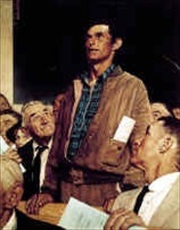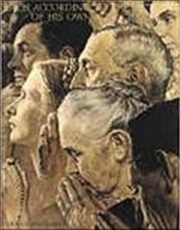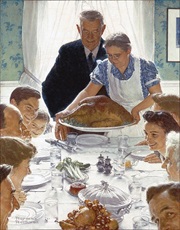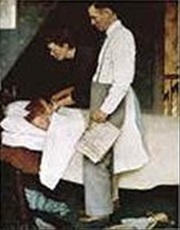ROOSEVELT’S LEND-LEASE TO AID WAR AGAINST AXIS
Washington, D.C. • January 6, 1941
Three days after Adolf Hitler had sent his Wehrmacht (German armed forces) into neighboring Poland on September 1, 1939, Great Britain and France declared war on Nazi Germany. Nine months later, following France’s surrender to the Wehrmacht in June 1940, the British government, which since 1939 had been paying for arms and other goods to fight the Nazi juggernaut using its gold reserves under the U.S. “cash and carry” program, had liquidated so many of its assets that the Nazi holdout was running short of cash. (The “cash and carry” revision to the U.S. Neutrality Acts of of the 1930s permitted the sale of war material to belligerent nations as long as they arranged for its transport in their own bottoms and paid cash on the barrelhead.)On this date, January 6, 1941, in his annual State of the Union address to members of the U.S. Congress, President Franklin D. Roosevelt proposed Lend-Lease assistance to the Allies fighting the Axis scourge: Nazi Germany, Fascist Italy, and Imperial Japan. The proposal followed on Roosevelt’s December 29, 1940, radio address during which he proclaimed the U.S. would be the “arsenal of democracy,” arming and supporting the Western democracies in Europe and to a lesser extent the Nationalist Chinese in their fight-to-the-death against the forces of tyranny and enslavement. Enacted on March 11, 1941, Lend-Lease was a program under which the United States—technically a noncombatant—supplied military aid (warships, warplanes, tanks, and other weaponry) as well as aid of an economic nature (food, oil, railway equipment, trucks and jeeps, clothing, blankets, and army boots) to countries whose defense the president deemed vital to the U.S. The act established the Office of Lend-Lease Administration, which disburse monies from 1941 to the conclusion of the war against Japan, the last Axis holdout, in August 1945. In general the aid was free. In return the U.S. was given 99-year, rent-free leases on naval and air bases in British and Commonwealth territories during the war.
Over $50 billion (equivalent to $887,430,635,838 in 2023) worth of supplies were shipped to U.S. allies, equivalent to 17 percent of total U.S. war expenditures following initial Congressional authorization of $7 billion. The money took the form of interest-free credit; in accordance with the Lend-Lease bill, the debts were to be paid after the war. In all, $31.4 billion in Lend-Lease materials went to hard-pressed Great Britain (“the spearhead of resistance to world conquest,” as Roosevelt called that country in December 1940) followed by $11.3 billion to the Soviet Union. Some $3.2 billion went to France, $1.6 billion to Nationalist China, and the remaining $2.6 billion to other Allies. (Canada operated a similar program called Mutual Aid, loaning $1 billion in supplies and $3.4 billion to Britain and other Allies.) Lend-Lease effectively ended the United States’ pretense of neutrality vis-à-vis the Axis and was a decisive retreat from the policy of noninterventionism that had been characteristic of U.S. foreign policy since the early Thirties. Wartime Prime Minister Winston Churchill expressed his appreciation on behalf of Great Britain for the Lend-Lease measure, calling it a “new Magna Charta.”
![]()
Norman Rockwell’s Four Freedoms, Oil on Canvas, 1943
In his State of the Union Address to the U.S. Congress on January 6, 1941, President Roosevelt outlined his desire for a world based, not on a “new order of tyranny”—an allusion to the “new European order” championed by Nazi Germany and Fascist Italy—but on four essential human rights: freedom of speech, freedom of worship, freedom from want, and freedom from fear. These essential rights hearkened back to the Atlantic Charter, a joint statement of postwar aims signed by Roosevelt and Churchill at Placentia Bay, Newfoundland, in mid‑August 1939. The illustrator Norman Rockwell created a quartet of paintings depicting these Four Freedoms that was first published in the Saturday Evening Post. In 1943 the Office of War Information printed 240,000 copies of Rockwell’s Four Freedoms to be used as an incentive for war bond purchasers. Sales of the posters and the tour of Rockwell’s four paintings to major American cities raised more than $130 million in war bond sales.
 |  |
 |  |
Top Row (L–R): Freedom of Speech, Freedom of Worship
Bottom Row (L–R): Freedom from Want, Freedom from Fear
Listen to President Roosevelt’s Four Freedoms Speech
Roosevelt Proposes the Lend-Lease Program to the U.S. Congress, Urging Americans to Become the “Arsenal of Democracy”
![]()

 History buffs, there is good news! The Daily Chronicles of World War II is now available as an ebook for $4.99 on Amazon.com. Containing a year’s worth of dated entries from this website, the ebook brings the story of this tumultuous era to life in a compelling, authoritative, and succinct manner. Featuring inventive navigation aids, the ebook enables readers to instantly move forward or backward by month and date to different dated entries. Simple and elegant! Click
History buffs, there is good news! The Daily Chronicles of World War II is now available as an ebook for $4.99 on Amazon.com. Containing a year’s worth of dated entries from this website, the ebook brings the story of this tumultuous era to life in a compelling, authoritative, and succinct manner. Featuring inventive navigation aids, the ebook enables readers to instantly move forward or backward by month and date to different dated entries. Simple and elegant! Click 











